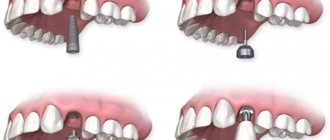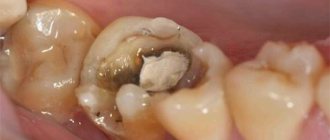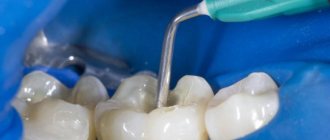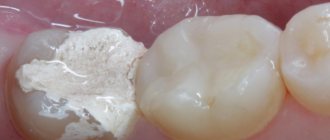Modern dental technologies make it possible to save a tooth even if it is severely damaged. For advanced caries and the complications that often accompany it, treatment is carried out in stages. First, medicine is placed into the canals, and only after some time the tooth is filled permanently. This explains why a temporary filling is placed. Depending on the clinical picture, the period of its use may vary.
Temporary filling: what is it and what is it for?
If urgent treatment is not possible, temporary filling material is placed. It does not have sufficient strength, so it is not suitable for permanent filling. But it allows you to close the tooth cavity for a certain period.
A temporary filling is placed in the treatment of pulpitis and periodontitis after cleaning the canal. It is also needed for diagnostics, when it is necessary to determine the nature of the inflammatory process and check how deep the damage is. Why is such material used for prosthetics and indirect restoration? It will protect the prepared tooth until the permanent structures are ready.
This is an excellent technique when you need to delay treatment. It also acts as a kind of insurance for the doctor, as it allows you to monitor the effect of treatment and prevent the occurrence of complications. Why do they put a temporary filling after the medicine? It will prevent the drug from seeping into the oral cavity. This method is used when devitalizing paste is applied or root canals are filled with medicinal pastes. After some time, you can clean the canal and fill the tooth.
Stages of root canal treatment
Endodontic treatment is carried out in several stages, namely:
- Professional oral hygiene.
- Providing access to the channel.
- Removal of nerves and pulp.
- Mechanical and medicinal treatment of root canals.
- Temporary tooth filling.
- Permanent tooth filling and restoration of its shape.
If the essence and purpose of almost all stages are more or less clear, then not everyone knows why temporary tooth filling is necessary during endodontic treatment.
Further in the article we will tell you why temporary filling is performed, why a temporary filling is placed after root canal filling, what indications for this procedure exist and why a tooth may hurt after temporary filling.
Types of temporary fillings
Such fillings are made from environmentally friendly materials and therefore do not have a toxic effect on the body. They are flexible, easy to install, and harden quickly. Apply evenly. The following types of temporary fillings are often used in dentistry:
- Artificial dentin. The drug consists of zinc oxide, kaolin, dehydrated zinc sulfate. The substance is paste-like, which is achieved by adding water. It hardens in just 3 minutes. Often used to determine the shade of a permanent restoration - before a crown
. - Dentin pastes. The composition
of the product is the same as the previous drug. The difference is that it is mixed with essential oils. The hardening time is longer, but its strength is also better. - Karyosan. Used for filling canals.
- Zinc-evengel cement. Suitable for cases where the dental nerve is inflamed. Used as a local anesthetic.
- Polycarboxylate cement has been used in dentistry for a long time. This material hardens quickly.
- Vinoxol. Used when long-term treatment is expected.
Such compositions differ from materials that are used for permanent fillings. In the future, they must be changed.
Intermediate filling materials
- A paste based on zinc sulfate and kaolin allows you to restore the crown of the tooth.
- Karyosan has an analgesic and antiseptic effect.
- Vinoxol is an artificial dentin. Withstands chewing load for up to 1-2 months.
- Cement with zinc and eugenol. It is used for antiseptic treatment of tooth tissue and relief of the inflammatory process.
- Glass ionomer cement is used for temporary fixation of the prosthesis.
- One-component polymer materials are pastes with a viscous consistency that harden under the light of a special lamp.
Filling using temporary materials
More often, such compositions are used after therapeutic and endodontic treatment. In most cases, they are preceded by x-ray diagnostics, which makes it possible to determine the type of damage and the extent of inflammation. Local anesthesia allows you to prepare, clean the carious cavity, remove the pulp and clean the canals without pain. To install a temporary filling, perform the following steps:
- treat the oral cavity with antiseptic agents;
- lay a medical pad - when required by the treatment protocol;
- filling material is placed on the tooth.
In acute periodontal disease, all actions are performed 2–3 times, so temporary compounds are used to fill the canals repeatedly. It's easy to remove them. To do this, the dentist will need a drill and hand tools.
Problems when wearing temporary dental fillings
Sometimes it happens that a temporary filling is too soft, then it needs to be changed so as not to disturb the chewing process. It happens that a temporary filling crumbles, tastes bitter, has an unpleasant taste in the mouth, or the tooth hurts when pressed - these are also reasons for premature removal. But the most dangerous situation is when the filling falls out. If you have any concerns about filling, you should contact your dentist.
Cementing with arsenic is becoming less common due to the unsafety of this method. Light-curing pastes dry instantly, have a natural color and do not harm the body, and they can be installed for 15-20 Euros.
You can get even more information at a free consultation at dental clinics in Estonia, a full list of which is presented on our website.
Wearing period
By determining how long a temporary filling material is placed, we can talk about its service life and the maximum possible wear without damage to the teeth. In each case, the doctor selects the most suitable composition, which has its own strength. In addition to the properties of the material, the quality of hygiene affects the service life. But if you are interested in how long it takes to walk with such a filling, you can focus on the following data:
- 1–7 days - for pulpitis, advanced caries;
- 1–3 weeks - when eliminating inflammation in the root canals;
- up to 3 months - when you need to treat a cyst, granuloma.
Based on the clinical picture and the manipulations performed, the doctor will determine the exact period of the temporary filling.
Material of manufacture
Requirements for temporary filling materials:
- no toxic effect on tooth structures (enamel, dentin, pulp) and mucous membranes of the oral cavity;
- safety for human health;
- chemical inertness and high resistance to saliva and aggressive environments (alkalies, acids);
- mechanical strength, wear resistance, ductility;
- lack of galvanization effect;
- maintaining shape and size during hardening;
- good radiopacity.
The choice of material for a temporary filling depends on the clinical case, age, individual characteristics of the body (the presence of allergies to certain substances), as well as how long the patient will wear it.
What to do if a filling falls out
If the filling material falls out earlier, you should contact your doctor. In this case, there are two options for his action: either he will install a permanent filling, or he will again install a temporary one. Before visiting the doctor, you need to rinse your mouth with soda solution, mouthwash, and carefully follow the rules of hygiene.
The main thing is not to walk around with open channels, because why do they do it?
temporary fillings then? A depressurized carious cavity threatens the development of inflammation and complications.
How long does it take to wear a temporary filling?
Depending on the material of manufacture, a temporary filling has different characteristics of strength and tightness and can last from several days to six months.
Average duration of use of a temporary filling:
- 2-3 days, if a drug is placed under the filling that destroys the nerve endings of the pulp;
- 7–10 days while treatment of the inflammatory process with periodontitis or pulpitis continues;
- 2-3 weeks - for the period of manufacture of the orthopedic structure;
- several months in special diagnostic cases (when treating a dental cyst, restoring dentin after deep caries).
It is necessary to strictly adhere to the timing of wearing temporary fillings. If the time period is extended, its integrity and sealing may be compromised, which will negatively affect the health of the tooth. Thus, arsenic-based paste, if not removed after 2-3 days, begins to penetrate the dentin through the tubules, destroying bone tissue.
How long a temporary filling can be worn is decided by the attending physician, depending on the diagnosis and the chosen treatment method.
Removing a temporary filling is a mandatory procedure before placing a permanent filling. After removal of the temporary composite, antiseptic treatment of the root canals and dental cavity is carried out. Next, a permanent filling is installed.
Rules of care
Compliance with the hygienist’s recommendations for temporary filling is one of the main conditions for effective therapy. You should brush your teeth twice a day and rinse them after eating. It is worth using a soft toothbrush. The use of whitening or abrasive toothpastes is not recommended.
Before permanent filling or restoration, it is better to avoid nuts, crackers, toffees and other products that place increased stress on such compounds. For several days after the filling is placed, it is better not to use coloring products, as they can change the color of the material. It is important to follow your doctor's recommendations. For example, during an inflammatory process, he may prescribe rinsing with antibacterial drugs.
Types of dental fillings, their cost, pros and cons
They are an alloy of metals with mercury. Yes, yes, you heard right - until recently, such fillings were installed en masse on chewing teeth. Silver amalgam contained up to 60% silver and very little mercury, and was more dangerous for the doctor during the manufacturing process than for the patient. The finished mass could not be called particularly toxic, but there was little joy from it aesthetically. And it took 3-4 hours to harden, not to mention the fact that sudden changes in cold and hot could lead to cracks in the amalgam. Even the obvious plus - excellent wear resistance - cannot cover the other disadvantages of any type of metal fillings. Currently, they are practically not installed even in public dentistry, not to mention elite clinics.
Cement fillings
A budget option when you simply don’t have enough finances for anything more. They are considered “better than nothing” and will at least cover the tooth cavity until they fall out. Permanent cement fillings should not be confused with dental cement, which is used to fix orthopedic structures and microprostheses: they use a special, especially durable material. Standard cement fillings are made from phosphate or glass ionomer cements. They are easy to knead, they are very cheap, but that’s probably where their advantages end. Even if the doctor performs the filling with exceptional care, he will not be able to achieve a perfect fit of the filling to the walls. The doctor does not have the opportunity to work with this type of material inside the tooth cavity, because... the cement sets in a matter of minutes. Over time, a gap will form between the filling and the tooth wall, where food debris and bacteria will find a home. The strength of cement fillings also leaves much to be desired; they wear out quickly. To be fair, it should be noted that glass ionomer cements have found their use in pediatric dentistry and are installed on baby teeth, but they cannot be seriously considered as full-fledged restorations in adults.
Plastic fillings
They are produced on the dental market:
- acrylic based;
- based on epoxy resins.
Acrylic fillings made of plastic have proven themselves well in aesthetic terms, because... the material has a wide color palette to choose the desired shade. Sufficient professionalism of the doctor will allow the filling to last for several years and withstand normal chewing loads. But, alas, this type also has disadvantages. Plastic is a porous material where bacteria settle, contributing to the development of dental pathologies. Acrylic fillings cannot be installed in case of deep caries, because... There is a high risk of pulpitis occurring after some time. If the patient often consumes dyes or smokes, the filling will quickly darken and lose its appearance.
Fillings based on epoxy resins have better characteristics than acrylic polymers. Toxicity still occurs, but here it is much less. Fillings of this type are more durable and safer, but they cannot be used to restore the frontal group due to the fragility of the material. And the resin-based composition darkens after just a couple of years. Thus, the object of their use remains chewing teeth.
How long does a temporary filling last and how is it removed?
The estimated service life of a temporary filling is 3-7 days (in rare cases, when using Vinoxol - 4-6 months). As practice shows, it can last on its own for 2 weeks or even a month, but such periods can have a detrimental effect on the effectiveness of treatment of a dental problem and even harm the teeth, so doctors independently remove the filling at the appointed time.
Removal is carried out by a doctor in a dental office; the removal technique directly depends on the type of material installed. For example, artificial dentin has a fairly low density - this allows removal using a medical spatula and curettes. To remove fillings made of high-strength materials, a drill can be used.
Note! In the first hours after the installation of a temporary filling, painful sensations may occur - this is due to injury to the dental and gum tissues during manipulation. If the pain does not go away within 24 hours, consult a doctor!











